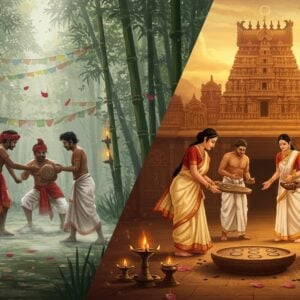
India’s ancient languages form the bedrock of its rich cultural and historical tapestry. These languages have profoundly influenced India’s diverse traditions and continue to shape modern practices, from religious ceremonies to literature and everyday communication. Delving into these languages provides invaluable insights into India’s captivating history and heritage, unveiling a mosaic of linguistic diversity that showcases the country’s intricate cultural landscape.
Exploring India’s Ancient Linguistic Heritage
Ancient Indian languages are more than just tools for communication; they are windows into the past, offering glimpses into the beliefs, rituals, and artistic expressions of ancient civilizations. They hold a wealth of knowledge, preserving the wisdom, philosophies, and cultural nuances of generations. By studying these languages, we gain a deeper appreciation for India’s historical trajectory and its enduring cultural legacy.
Major Language Families of Ancient India
The linguistic landscape of ancient India is dominated by two major language families: Indo-Aryan and Dravidian. These families encompass a diverse range of languages, each with its own distinct characteristics and historical significance.
1. Indo-Aryan Languages
- Origins and Development: The Indo-Aryan languages are believed to have originated from Central Asia, brought to the Indian subcontinent by Indo-Aryan migrations around 1800 BCE. They evolved from Old Indic, progressing through Middle Indic Prakrit languages and Apabhraṃśa during the Middle Ages. This evolution reflects a dynamic interaction between language and cultural change over centuries.
- Sanskrit: The Mother of Languages: Sanskrit, often regarded as the earliest recorded language of ancient India, holds a revered position in Indian culture and scholarship. Attributed to the Aryans, it reached its peak of linguistic sophistication by the 4th century BCE under the grammarian Panini. Sanskrit served as the language of religious texts, scholarly works, and administration, leaving an indelible mark on India’s intellectual and spiritual heritage. It’s often referred to as the “Mother of Languages” due to its significant influence on numerous other languages.
- Prakrit: The Vernacular Languages: Prakrit languages, a group of vernacular Middle Indo-Aryan languages, were widely spoken in ancient India. These languages played a vital role in the daily lives of common people and were also used in early Jain and Buddhist texts, reflecting their broader cultural and religious significance. Modern languages like Marathi, Hindi, Bangla, Gujarati, and Punjabi trace their roots back to Prakrit.
- Pali: The Language of Buddhist Scriptures: Pali, an ancient language of Indian origin, holds a special place in the history of Buddhism. It served as the language of early Buddhist scriptures, playing a crucial role in the dissemination of Buddhist teachings across different regions. Pali remains a key language for those studying Buddhist philosophy and history.
2. Dravidian Languages
- Indigenous Roots: The Dravidian language family is considered indigenous to India, predating the arrival of Indo-Aryan languages. These languages were likely widespread across the Indian subcontinent before 1800 BCE, representing an ancient linguistic lineage that has shaped the cultural identity of South India.
- Tamil: A Classical Language with a Rich History: Tamil, a prominent Dravidian language, boasts a history of around 5000 years. Its classical status and rich literary tradition highlight its enduring importance. Tamil is recognized as one of the oldest living languages globally, a testament to its continuous usage and cultural significance. Poojn.in offers a variety of puja items related to Tamil traditions.
- Kannada, Telugu, and Malayalam: Other Prominent Dravidian Languages: Kannada, Telugu, and Malayalam are other significant Dravidian languages, each with a rich history and literary heritage. These languages have roots stretching back over 2000 years, contributing to the cultural diversity of South India.
3. Other Language Families
- Austroasiatic Languages: The Austroasiatic language family is represented in India by the Munda languages, primarily spoken by tribal populations in Central India. These languages offer unique insights into the linguistic and cultural diversity of the region.
- Tibeto-Burman Languages: The Tibeto-Burman languages constitute another language family present in India, particularly in the northeastern and Himalayan regions. These languages reflect the cultural connections and linguistic influences from the Tibetan and Burmese regions.
Timeline and Evolution of Ancient Indian Languages
Tracing the evolution of these languages offers a fascinating glimpse into the development of language and culture in India.
- Proto-Indo-European (around 6,000 years ago): This is considered the ancestor of all Indo-European languages, including the Indo-Aryan languages of India.
- Proto-Indo-Iranian (late 3rd millennium BC): This represents the common ancestor of Indo-Aryan, Iranian, and Nuristani languages.
- Proto-Dravidian (early 3rd millennium BCE): This hypothetical language is believed to be the ancestor of all Dravidian languages.
- Vedic Sanskrit (second millennium BCE): This is the language of the Vedas, the oldest sacred texts of Hinduism.
- Classical Sanskrit (4th century BCE): Sanskrit reached its standardized form under Panini, becoming the language of scholarship and literature.
- Old Tamil (6th century BCE): This marks the emergence of Old Tamil, paving the way for the development of modern Tamil.
The Significance of Ancient Indian Languages
Ancient Indian languages are not mere relics of the past; they are living traditions that continue to shape India’s cultural identity. They provide invaluable insights into the history, culture, and evolution of Indian society.
These languages hold a rich literary heritage, preserving the collective wisdom, philosophical thoughts, and artistic expressions of countless generations. Poojn.in provides access to a collection of books and teachings related to these ancient languages. Studying these languages helps us connect the past with the present, fostering a deeper understanding of our shared human experience. They preserve the intricate tapestry of human civilization, reminding us of the rich diversity and cultural depth that has shaped India’s unique identity. As we explore these ancient languages, we embark on a journey of discovery, connecting with the wisdom of our ancestors and enriching our appreciation for the vibrant cultural legacy that continues to inspire us today. You can find various products at Poojn.in that connect to these traditions.


